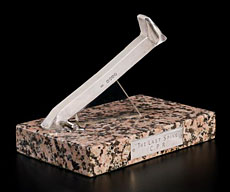The Silver Spike Meant to Unite Canada
November 1, 2012
Ceremonial Last Spike, silver mounted on granite from the Van Horne collection, Photo Marie-Louise Deruaz, IMG2012-0232-0001-Dm © Canadian Museum of Civilization
Builder of the Canadian Pacific Railroad, international business tycoon, fine arts collector, artist, gentleman farmer, senior figure in high society—Sir William Cornelius Van Horne (1843–1915) was an extraordinary man. And he left to his descendants an extraordinary collection of documents and artifacts, the prize of which is the ceremonial silver “Last Spike” intended to complete the Canadian Pacific Railway (CPR). Recently, heirs of Sir William chose to donate this collection—which also includes paintings, letters, books, photographs and items from Van Horne’s household—to the Canadian Museum of Civilization.
The ceremonial silver spike was a gift to Sir William from Canada’s Governor General, Lord Lansdowne, who had intended to hammer it into the completed track during the famous “last spike” ceremony at Craigellachie, British Columbia in 1885. But a snow storm prevented Lord Lansdowne from reaching Craigellachie, where a regular iron spike was hammered in by senior CPR director Donald Alexander Smith. Lord Lansdowne mounted the silver spike on a granite base and sent it to Van Horne as a token of his appreciation for Sir William’s essential role as general manager of the CPR. The Van Horne collection also includes a fascinating exchange of letters between Lord Lansdowne and Van Horne.
“The Canadian Museum of Civilization was the ideal home for the ceremonial spike, the letters about the spike and the other items in the Van Horne collection,” explains Sally Hannon, a member of the donor family. “Sir William’s legacy now becomes part of Canada’s national history collection, available to all Canadians in perpetuity.”
Born in Illinois, Sir William became a naturalized Canadian citizen in 1914, a year before his death.
Honouring a Rich Family Legacy
“It’s hard to think of an object more symbolic of uniting Canada than the ceremonial last spike intended for the railway that linked the St. Lawrence–Great Lakes heartland and the developing West,” says Dr. David A. Morrison, Director of Archaeology and History at the Canadian Museum of Civilization. “By making this generous donation, Sir William’s heirs have ensured that this symbol of Sir William’s greatest achievement will have a permanent home in Canada’s national museum of history.”
Sally Hannon is a niece of Sir William’s grandson William (Bill) Van Horne, whose wife Margaret Van Horne maintained for many years Sir William’s residence in Montreal. “The collection was donated in Margaret’s name in recognition of our family’s gratitude for her stewardship of the collection for many years,” says Sally Hannon.